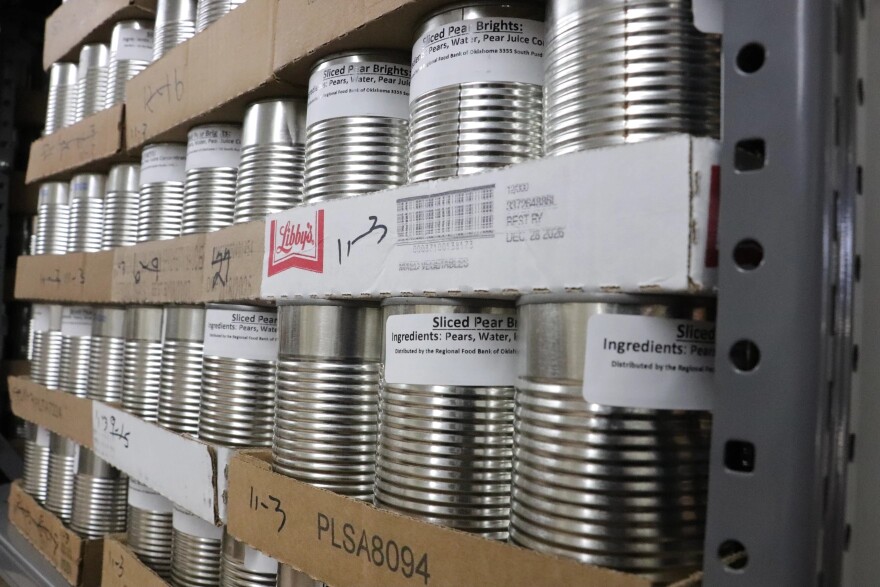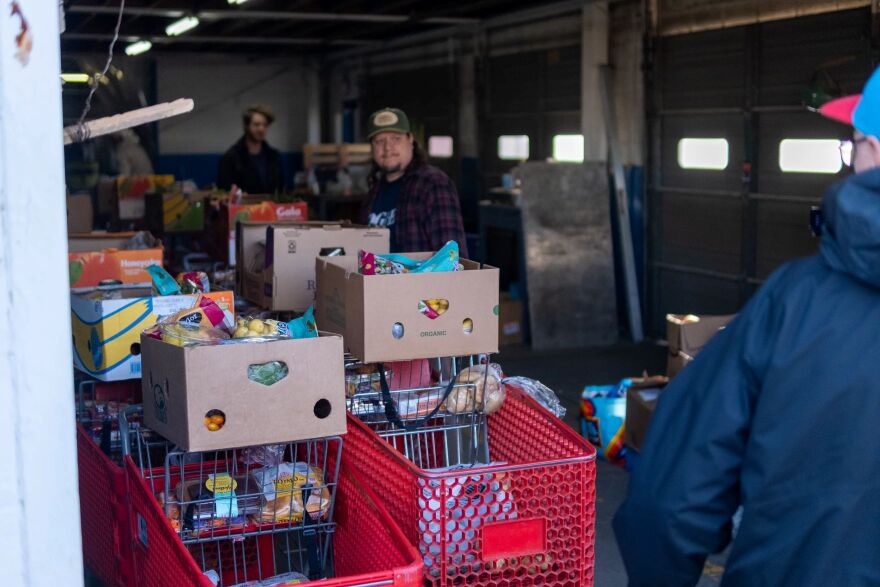Wesley Bradley knows how to make his food assistance stretch. Breakfast is not necessarily bacon, eggs or sausage; it can be a bowl of oatmeal or cereal.
“Sometimes I have a bowl, sometimes I don’t,” said Bradley, who was waiting for food outside the Urban Mission in Oklahoma City on a recent November morning.
Bradley, who is a military veteran, receives about $120 monthly for groceries through the Supplemental Nutrition Assistance Program, or SNAP. He’s one of more than 41 million people across the U.S. who had their food aid halted earlier this month during the federal government shutdown.
Food banks and pantries have experienced unprecedented demand in the past few weeks, as people went without all or some of their SNAP benefits and many government employees missed paychecks.

The stalemate in Congress is over now, and SNAP benefits are once again flowing. But food resource organizations in the central U.S. expect demand to remain through the holiday season.
Many people impacted by the shutdown took on additional debt or tapped into their savings, said Beth Corbett with the Central Texas Food Bank. November and December are always times of increased need, and she expects this year will be even higher.
“Those types of financial disruptions don’t just go away when the government reopens,” Corbett said. “We certainly expect a sustained and lingering impact for the months ahead.”
A 300% increase
Oklahoma and Texas are among the most food-insecure states in the nation.
Corbett with the Central Texas Food Bank said many households might have visited a pantry for the first time during the shutdown.
“We're seeing at minimum, really in these last couple of weeks, a 50% increase in folks accessing our distributions,” Corbett said. “Some sites we've seen up to a 300% increase.”
The bank services a 21-county area, which has about 47,000 federal employees and about 270,000 SNAP shoppers, according to Corbett.
Before the government lapse, Corbett said the bank spent about $1.3 million monthly to purchase food on top of donated goods. During the shutdown, that spending leaped to $1 million a week.
The widespread demand made it difficult to fundraise or source food, since every food bank across the nation was doing the same, Corbett said. She said the bank purchased food it wouldn’t normally buy to meet people’s needs, like milk or eggs.
Eric Cooper, president and CEO of the San Antonio Food Bank in Texas, said the shutdown demand came on the heels of a tough year that already stretched the bank’s inventory.
Federal budget cuts at the beginning of the year shrunk the bank’s food supply, he said. The organization also responded to new demand brought on by the deadly Hill Country flooding over the summer.
“I think we're doing all we can,” Cooper said. “The shutdown has brought this crazy uncertainty, but our community has certainly delivered.”
There have been more donations in recent weeks, he said, and volunteers jumped from 2,000 to almost 3,000 people. The additional support allowed the bank to tack on another distribution time slot. But the bank also had to ration.
Instead of offering a week’s worth of food, Cooper said the bank was giving enough for about three to five days.

In Illinois, the Gibson Area Food Pantry serves mainly rural communities across 15 counties through the Gibson Area Hospital & Health Services. Joshua Johnson, executive director of communications at the hospital, said accessibility can be hard in rural areas, and the pantry helps fill the need through deliveries or the pantry site.
Recently, he said the pantry has seen upwards of 50% more people seeking its services, and he doesn’t anticipate that to go away over the holidays. He said the pantry is fortunate to be able to handle the increased demand because the hospital helps to support efforts.
“You never know who is facing a hunger situation and a food shortage,” Johnson said. “It could be your next door neighbor. It could be somebody that you absolutely would not ever think may have this issue.”
'It's really difficult'
An increase of donations and volunteers at the Urban Mission in Oklahoma City has made a huge difference to help meet the current need, said Alex Jackson, the organization's program director. She said because of extra volunteers, the mission has been able to increase the number of families it can serve from 300 to 350 twice a week.

“I would expect even because of the holiday season, we're still going to be busy,” Jackson said. “So I think we'll meet capacity today. I bet we meet capacity for the rest of the year.”
Urban Mission's inventory was low before SNAP benefits were cut, and Jackson said donations plummeted because of the economy and high food prices. The mission had to make changes to some of its other programs to focus on distributing food.
Jackson said the organization has been working hard since the beginning of the shutdown, but the SNAP uncertainty has been tiring.
“We really want to help our community and we're really dedicated to that, but it really wears you out to not know what's going to happen next,” Jackson said. “We want to prepare. We want to be good at our jobs, and we want to serve people in the best way we can, but if we don't know what's coming, then it's really difficult.”
Urban Mission experienced record demand during the shutdown. But in the 12 years Jackson has been working at the mission, she has seen the need growing yearly. She said not enough people are aware of the state’s food insecurity.
“Sometimes I feel like I'm shouting into an echo chamber here. Oklahoma is one of the hungriest states in the nation, period, and it has been an issue for a long time,” Jackson said. “I'm so glad people have been aware of how important SNAP is to these families.”
This story was produced in partnership with Harvest Public Media, a collaboration of public media newsrooms in the Midwest and Great Plains. It reports on food systems, agriculture and rural issues.


